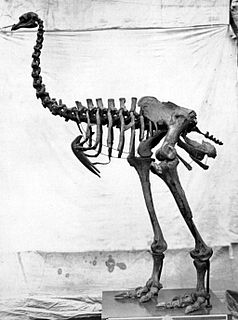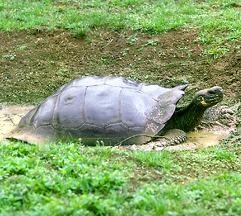
Tortoises are reptiles of the family Testudinidae of the order Testudines. They are particularly distinguished from other turtles by being exclusively land-dwelling, while many other turtle species are at least partly aquatic. Like other turtles, tortoises have a shell to protect from predation and other threats. The shell in tortoises is generally hard, and like other members of the suborder Cryptodira, they retract their necks and heads directly backwards into the shell to protect them.

The Pinta Island tortoise, also known as the Pinta giant tortoise, Abingdon Island tortoise, or Abingdon Island giant tortoise, was a species of Galápagos tortoise native to Ecuador's Pinta Island.

The marginated tortoise is a species of tortoise in the family Testudinidae. The species is endemic to Greece, Italy, and the Balkans in Southern Europe. It is the largest European tortoise. The marginated tortoise is herbivorous, and hibernates for the winter.

The Greek tortoise, also known commonly as the spur-thighed tortoise, is a species of tortoise in the family Testudinidae. Testudo graeca is one of five species of Mediterranean tortoises. The other four species are Hermann's tortoise, the Egyptian tortoise, the marginated tortoise, and the Russian tortoise. The Greek tortoise is a very long-lived animal, achieving a lifespan upwards of 125 years, with some unverified reports up to 200 years.

Floreana Island is an island of the Galápagos Islands. It was named after Juan José Flores, the first president of Ecuador, during whose administration the government of Ecuador took possession of the archipelago. It was previously called Charles Island, and Santa María after one of the caravels of Columbus.

Testudo, the Mediterranean tortoises, are a genus of tortoises found in North Africa, Western Asia, and Europe. Several species are under threat in the wild, mainly from habitat destruction.

Geochelone is a genus of tortoises.

Pachyornis is an extinct genus of ratites from New Zealand which belonged to the moa family. Like all ratites it was a member of the order Struthioniformes. The Struthioniformes are flightless birds with a sternum without a keel. They also have a distinctive palate. This genus contains three species, and are part of the Anomalopteryginae or lesser moa subfamily. Pachyornis moa were the stoutest and most heavy-legged genus of the family. The most notable species being Pachyornis elephantopus - the Heavy-Footed Moa. They were generally similar to the Eastern Moa or the Broad-billed moa of the genus Euryapteryx, but differed in having a pointed bill and being more heavyset in general. At least one species is assumed to have had a crest of long feathers on its head. The species became rapidly extinct following human colonization of New Zealand, with the possible exception of P. australis, which may have already been extinct by then-although the most recent moa skeleton ever described is a partial skeleton of this species, radiocarbon dated to between 1396 and 1442.
T. terrestris may refer to:

The Galápagos tortoise complex or Galápagos giant tortoise complex is a species complex of 15 very large tortoise species in the genus Chelonoidis. They are the largest living species of tortoise, with some modern Galápagos tortoises weighing up to 417 kg (919 lb). With lifespans in the wild of over 100 years, they are one of the longest-lived vertebrates. Captive Galapagos tortoises can live up to 177 years. For example, a captive individual, Harriet, lived for at least 175 years. Spanish explorers, who discovered the islands in the 16th century, named them after the Spanish galápago, meaning "tortoise".

Kleinmann's tortoise, also called commonly the Egyptian tortoise, Leith's tortoise, and the Negev tortoise, is a critically endangered species of neck-hiding tortoise in the family Testudinidae. The species is native to Egypt, Libya, and Israel. The species was once more widespread, but its numbers are now dwindling. The species is nearly extinct in Egypt, and complete extinction in the wild is a looming threat unless more actions are taken to protect this species.

The yellow-footed tortoise, also known as the Brazilian giant tortoise, commonly referred to as the Brazilian giant turtle, or more commonly, the big turtle, is a species of tortoise in the family Testudinidae and is closely related to the red-footed tortoise. It is found in the Amazon Basin of South America. The species name has often been misspelled as denticulata, an error introduced in the 1980s when Chelonoidis was elevated to genus and mistakenly treated as feminine, an error recognized and fixed in 2017.

The heavy-footed moa is a species of moa from the family Dinornithidae. This moa was widespread only in the South Island of New Zealand, and its habitat was the lowlands. It was a ratite and a member of the order Struthioniformes. The Struthioniformes are flightless birds with a sternum without a keel. They also have a distinctive palate. The origin of these birds is becoming clearer as it is now believed that early ancestors of these birds were able to fly and flew to the southern areas in which they have been found.
Galápagos turtle may refer to:

The Volcán Wolf giant tortoise, also known commonly as the Wolf Volcano giant tortoise and the Cape Berkeley giant tortoise, is a species of Galápagos tortoise in the family Testudinidae. The species is native to the north side of Ecuador's Isabela Island. Chelonoidis becki has links to two different lineages including that of Chelonoidis darwini from the nearby island of Santiago. C. becki has been found to be the product of a double colonization event beginning around 199,000 years ago, and had been formed through introgression, where greater male selectivity was exhibited by purebred females in one of the lineages. It is most commonly found on the northern, western, and southwestern slopes of Volcán Wolf, the volcano that it is named for. Having evolved to live in a specific environment, C. becki only occupies an estimated range of about 263 square kilometers. An estimated 1,150 Volcán Wolf giant tortoises inhabit Volcán Wolf.
Giant tortoises are any of various large land tortoises

Chelonoidis vicina, commonly known as the Cerro Azul giant tortoise, Iguana Cove tortoise or the Isabela Island giant tortoise, is a species of Galápagos tortoise endemic to Isabela Island in the Galápagos.

The Santiago Island giant tortoise, also known commonly as the Santiago giant tortoise and the James Island tortoise, is a species of Galápagos tortoise in the family Testudinidae. The species is endemic to Santiago Island in the Galápagos.













